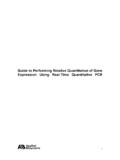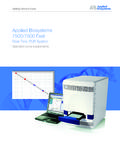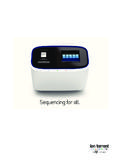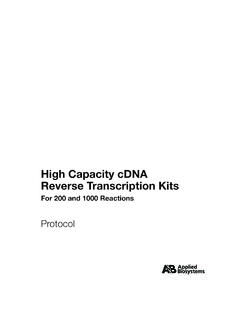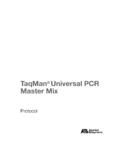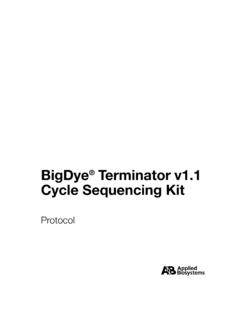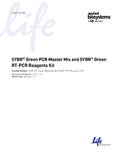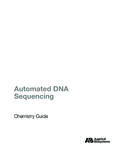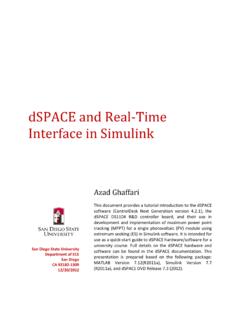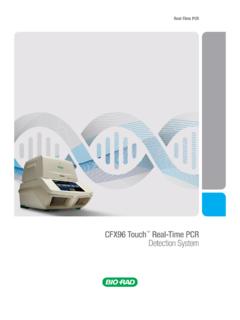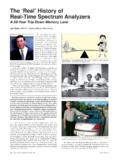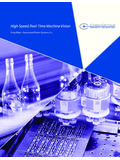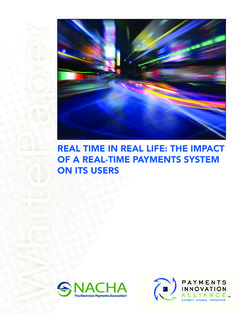Transcription of Real-time PCR: Understanding Ct - Applied …
1 APPLICATION NOTEReal- time PCRReal- time PCR: Understanding CtReal- time PCR, also called quantitative PCR or qPCR, can provide a simple and elegant method for determining the amount of a target sequence or gene that is present in a sample. Its very simplicity can sometimes lead to problems of overlooking some of the critical factors that make it work. This review will highlight these factors that must be considered when setting up and evaluating a Real-time PCR that can influence CtCt (threshold cycle) is the intersection between an amplification curve and a threshold line (Figure 1B). It is a relative measure of the concentration of target in the PCR reaction.
2 Many factors impact the absolute value of Ct besides the concentra-tion of the target. We will discuss the most common template-independent factors that can influence Ct and describe how to evaluate the performance of a Real-time PCR reaction. Figure 1 shows several parameters of the Real-time reaction amplification plot. The exponential phase in Figure 1B corresponds to the linear phase in Figure 1C. The threshold must be set in the linear phase of the amplification plot in Figure 1C. The Ct value increases with a decreasing amount of template. However, artifacts from the reaction mix or instrument that change the fluorescence measurements associated with the Ct calculation will result in template-independent changes to the Ct value.
3 Therefore, the Ct values from PCR reactions run under different conditions or with different reagents cannot be compared directly. 0 5 10 15 20 25 E + E + E + E + E + E + ROX Master Mix AMaster Mix BFigure 2. Raw fluorescence data obtained from one assay using two master mixes with the same ROX level. The difference in signal is due to the master mix composition. The reaction was performed on an Applied Biosystems 7900HT Fast Real-time PCR System using a VIC MGB probe. The x-axis shows the emission wavelength of the fluorophore and the y-axis shows the intensity of the 1. Graphical representation of Real-time PCR data.
4 Rn is the fluorescence of the reporter dye divided by the fluorescence of a passive reference dye; ,Rn is the reporter signal normalized to the fluorescence signal of ROX . (A) In this view, Rn is plotted against PCR cycle number. (B) Rn is Rn minus the baseline; Rn is plotted against PCR cycle number. (C) An amplification plot shows the variation of log ( Rn) with PCR cycle Rn1 2 3 4 5 6 7 8 9 10 11 12 13 14 15 16 17 18 19 20 21 22 23 24 25 26 27 28 29 30 31 32 33 34 35 36 37 38 39 40 Cycle number1000e + 0011000e + 0001000e - 0011000e - 0021000e - 0031000e - 004 Rn1 2 3 4 5 6 7 8 9 10 11 12 13 14 15 16 17 18 19 20 21 22 23 24 25 26 27 28 29 30 31 32 33 34 35 36 37 38 39 40 Cycle numberExponential phase1 2 3 4 5 6 7 8 9 10 11 12 13 14 15 16 17 18 19 20 21 22 23 24 25 26 27 28 29 30 31 32 33 34 35 36 37 38 39 Rn1 2 3 4 5 6 7 8 9 10 11 12 13 14 15 16 17 18 19 20 21 22 23 24 25 26 27 28 29 30 31 32 33 34 35 36 37 38 39 40 Cycle number1000e + 0011000e + 0001000e - 0011000e - 0021000e
5 - 0031000e - 004 Rn1 2 3 4 5 6 7 8 9 10 11 12 13 14 15 16 17 18 19 20 21 22 23 24 25 26 27 28 29 30 31 32 33 34 35 36 37 38 39 40 Cycle numberExponential phase1 2 3 4 5 6 7 8 9 10 11 12 13 14 15 16 17 18 19 20 21 22 23 24 25 26 27 28 29 30 31 32 33 34 35 36 37 38 39 40 ThresholdThresholdBaselinetThe effect of master mix components The fluorescence emission of any molecule is dependent on environmental factors such as the pH of a solution and salt concentration. Figure 2 shows the raw fluorescence data of a TaqMan probe in the background of two different master mixes. Note that the fluorescence intensity is higher in Master Mix A even though the target, probe, and ROX dye concentrations are the same in both cases.
6 The resulting Rn value will, therefore, vary as shown in Figure 3. Note that the baseline fluorescence signals, in a template-independent factor, are different for the two master mixes (Figure 3A). Variations in the Ct value do not reflect the overall performance of the reaction system (Figure 3B). Master mixes with equivalent sensitivity may have different absolute Ct values. ROX passive reference dyeThe Rn value is calculated as the ratio of the fluorescence of FAM dye divided by the fluorescence of ROX dye. Therefore, a lower amount of ROX dye would produce a higher Rn value assuming fluorescence signal from FAM dye is unchanged.
7 This would lead to an increase in baseline Rn and subsequently a smaller Rn as well as a different Ct value. The new Ct value obtained by lower-ing the level of ROX dye has no bearing on the true sensitivity of the reaction, but can have other unintended consequences. Low concentrations of ROX dye can result in increased standard deviation of the Ct value, as shown in Figure 4. The greater the standard deviation, the lower the confidence in distinguishing between small differences in target concentration (see the precision section on the next page). Efficiency of a PCR reactionThe efficiency of a PCR reaction can also affect Ct. A dilution series amplified under low efficiency conditions could yield a standard curve with a different slope from one amplified under high efficiency conditions.
8 In Figure 5, two samples (X and Y) amplified under low and high efficiency conditions show different Ct values for the same target concentration. In this example, although the high-efficiency condition (the blue curve in Figure 5) gives a later Ct at high concentrations, it results in better sensitivity at low target concentrations. The PCR efficiency is dependent on the assay, the master mix performance, and sample quality. Generally, an efficiency between 90 and 110% is considered observation that the Ct value produced from one sample is higher than that of 1 2 3 3 3 6 7 8 9 10 11 12 13 14 15 16 17 18 19 20 21 22 23 24 25 26 27 28 29 30 31 32 33 34 35 36 37 38 39 numberAMaster Mix ABaseline ABaseline BMaster Mix B1 2 3 3 3 6 7 8 9 10 11 12 13 14 15 16 17 18 19 20 21 22 23 24 25 26 27 28 29 30 31 32 33 34 35 36 37 38 39 ( Rn)Cycle numberBMaster Mix BMaster Mix ACtBCtARn vs.
9 CycleFigure 3. Amplification of RNase P in equal amounts of human gDNA using Master Mix A and Master Mix B. (A) Rn is plotted against cycle number and the baselines for both reactions are shown. (B) log ( Rn) is plotted against cycle number. The threshold (green line) is set at the same level for both master mixes. The Ct value of Master Mix B (CtB) is earlier than that of Master Mix A (CtA) for identical concentrations of target, reflecting the lower baseline of Master Mix B. All amplifications were performed using the Applied Biosystems 7500 Real-time PCR concentration ROX concentration deviationCt (VIC )Figure 4. Amplification of TGF-beta using master mixes containing 3 different concentrations of ROX dye.
10 The variation of (A) Ct value and (B) standard deviation with ROX dye concentration is shown. Decreasing the ROX dye concentration gives an earlier Ct, but increases the standard deviation. All amplifications were performed using the Applied Biosystems 7500 Real-time PCR other, could be valuable in concluding that there is less template in the first sample, assuming all other factors such as instruments, reagents, and assays are equal. However, this is not true if different instruments, reagents, primers and probes, or reaction volumes are involved in produc-ing the two Cts. Therefore, the absolute Ct value comparison is only meaningful when comparing experiments using the same reaction conditions as defined to evaluate the performance of a Real-time PCR reactionIn order to compare two reactions where a condition is changed (for example two different master mixes or two different instruments), the following parameters must be evaluated.
